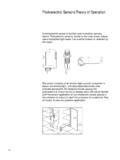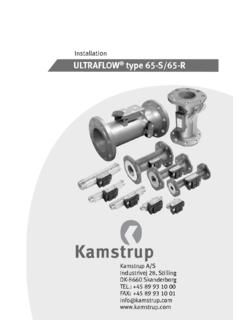Transcription of Sadev gear position sensor adapters - Geartronics
1 gear position sensor installation procedure When using any Geartronics closed-loop control system, it s important that the barrel position sensor is positioned correctly. Most rotary position sensors supplied by Geartronics are hall-effect devices that can measure 359 of rotation, and give an output of over this range. It s important to understand that it s impossible to measure the 0/360 position , and the sensor gives an indeterminate output when positioned in this 1 dead band . Identifying the dead band If you examine the sensor shaft, you will see an identification dot on one edge as shown in the photograph below. When this dot is pointing directly opposite the cable, the sensor is positioned in the dead band. Conversely, when the dot is aligned with the cable, the sensor is mid-travel and the output voltage will be It s very important that the sensor is positioned such that shaft never crosses the dead band when any gears are selected.
2 If the sensor crosses the dead band as the selector barrel moves from one gear to the next, then the gearbox control unit may receive a spurious signal and incorrectly re-apply engine power before the next gear has been engaged. Most gearboxes are designed so that the gear positions are symmetrical about the sensor mid position . However, there are some notable exceptions such as some Hewland gearboxes (NMT, NLT, LSG etc). It s very important that the sensor shaft is aligned correctly before fitting the sensor to the gearbox. This is especially important when working with gearboxes where the sensor is inaccessible once the gearbox is installed, such as Quaife 60G & 69G etc. Below is an example of a symmetrical calibration in the Geartronics software. Each of the coloured bands represents a gear position , with red indicating reverse gear and pink indicating 6th gear .
3 You can see from this calibration that the sensor will never cross the zero degree position as the selector barrel travels from reverse through to 6th. This shows the sensor positioned correctly. Note that 2nd & 3rd gears (grey & light green) are positioned either side of 180 , and this is typical of most gearboxes. The easiest method to use when fitting the sensor is to select either 2nd or 3rd gear and roughly align the dot with the cable, then fit the sensor in the nearest position without having to turn the shaft more than 20-25 in either direction. If the sensor is inserted with the shaft 180 out, then you will cross the dead band as you select between 2nd & 3rd gears this not correct! > The calibration below shows a typical Sadev calibration. The shift to neutral on the Sadev range of gearboxes allows a greater angle between the remainder of the gears.
4 This means that 3rd gear (light green) is positioned at 180 , and the sensor output voltage will be When using a Geartronics sensor adapter with a Sadev gearbox, it s very important to position the Sadev drive coupling so that reverse (red) and 6th (pink) gears are either side of the 0 position as shown above. Some trial and error will be required to position the sensor correctly, but the easiest method is to select 3rd gear , then rotate the sensor by hand to the 180 position (dot pointing at cable) before securing the drive coupling with the two grub screws. This photograph shows the adapter in position on an SCL82-14 with the gearbox in neutral. If, after reading this document, you are still unclear about how to fit the sensor then please contact Geartronics !
5 Geartronics 2012.







